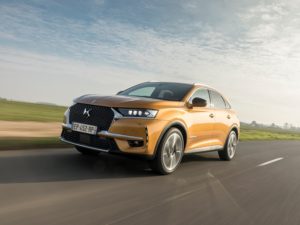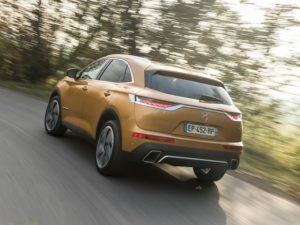First Drive: DS 7 Crossback E-Tense 4×4
Three years into life as a separate brand, DS not only wants to define itself as a little different to its more conservative German rivals, but as the most technologically advanced line-up in the PSA Group. So not only does the DS 7 Crossback give it the now-prerequisite SUV, but from 2019 this will also become the Group’s first plug-in hybrid.

DS 7 Crossback E-Tense 4×4
PSA has made no secret of its ambitions. It has plans for seven plug-in hybrids and four electric vehicles by 2021, across two platforms, not including products which will launch under its recently-acquired Vauxhall and Opel brands. DS, with its focus on technology, will lead the charge, with a range of high-performance plug-ins badged ‘E-Tense’, as a nod to the concept car of the same name.
There’s some familiarity in terms of layout, but the DS 7’s drivetrain isn’t related to the now-discontinued Hybrid4 system which had been used by early versions of the DS 5. It has a a 107bhp electric rear axle with no mechanical connection to the front wheels, but beneath the bonnet is a second 107bhp electric motor sharing an eight-speed automatic transmission with a 197bhp 1.6-litre turbocharged petrol engine. Fully charged, the 13kWh battery under the rear bench offers a range of between 30 and 35 miles without using any fuel.

DS 7 Crossback E-Tense 4×4
This is a neat setup; there’s no loss of cabin or boot space, and the charging port is tucked away behind what looks like a fuel flap on the left-hand rear wing. DS isn’t offering a rapid charging option, despite the battery capacity being around 50% larger than most plug-in hybrids, but the DS 7 Crossback can take a 7kW charge, meaning it takes around two hours to fill.
Some 18 months from launch, we were only able to test the E-Tense for a short distance in very early prototype form. As such, it’s hard to comment on range, though DS claims 30 miles under the new WLTP test cycle, and only two of the drive modes were available. Production models will offer the usual choice of fully electric, sport, eco and hybrid modes, to suit the route ahead.
Even so, it’s possible to get some idea of the performance on offer. The system offers electric four-wheel drive, but it’s set up to prioritise drive to the rear axle. While it adds around 250kg to the kerb weight, that direct drive from the motor to the wheels mean it’s surprisingly quick off the mark. It doesn’t feel significantly heavier than the petrol or diesel models, and it’s not overly keen to bring the petrol engine to life in EV mode. Prod the throttle heavily, and the combined 297bhp gives urgent, if not blistering, straight-line pace.

DS 7 Crossback E-Tense 4×4
DS is only too aware that this sort of product is in demand in the UK; the E-Tense is expected to take around 20-25% of the DS 7 Crossback’s UK volume, and that will be weighted towards fleets. It also launches just in time to take advantage of the revised company car tax system in 2020/21, which should help. Though, at £50,000 before incentives, it’ll get penalised by the VED supplement for expensive vehicles. DS will also have plenty of competition by 2019, despite its predicted rivals (X1, Evoque and XC40 among them) not having plug-in offers yet.
Overall, there’s plenty of promise here. DS has its work cut out finding its feet among established brands, but products like the E-Tense can only help. We’ll be interested to try it once it reaches production form to get a clearer sense of what should be very important new technology for the PSA Group.
Verdict:
It’s an ambitiously high-priced vehicle for DS, but aiming for a popular segment and offering tax advantages for fleets should help the DS 7 Crossback find its place in the market. Ironically, plug-in hybrid versions of the Peugeot 3008 and 5008 might be among its biggest threats at first.
Specification:
Segment: Crossover
Type: Petrol plug-in hybrid
Price: £50,000 (not including Plug-in Car Grant)
Fuel: 160mpg (NEDC, estimate)
Electric range: 36 miles (NEDC) 30 miles (WLTP) (estimate)
CO2 emissions (tailpipe): 40g/km (estimate)
Charging Port: Type 2 AC

